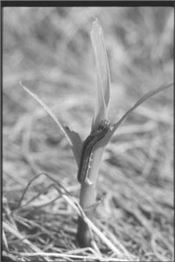Watch Pastures For True Armyworm
DR. RIC BESSIN
PRINCETON, KEN.
There has been one report of true armyworm in pastures, and moth numbers increased dramatically the week before last in Lexington. While I also have a KPN article on fall armyworm in western Kentucky this week, keep in mind these are two separate insect pests. The true armyworm overwinters in Kentucky and can be a serious early season pest of pastures, small grains, and corn. Cool, wet weather can favor armyworm development, and we have had some of that this year. Armyworm larvae are highly active at night and on cloudy days. With this late occurrence, producers should monitor pastures and late-planted corn for true armyworm activity.
While moth numbers are up, they are a small fraction of the numbers we experienced during the 2008 outbreak year. When larvae are a problem, they damage plants by eating leaf margins of upper leaves, defoliating entire plants, and clipping heads of maturing plants. In pastures, we would suggest treatment when armyworm numbers reach two to three per square foot. ∆
DR. RIC BESSIN: Entomology Extension Specialist, University of Kentucky

Figure 1. True armyworm with typical leaf margin injury to seedling corn.
Photo: Ric Bessin, UK